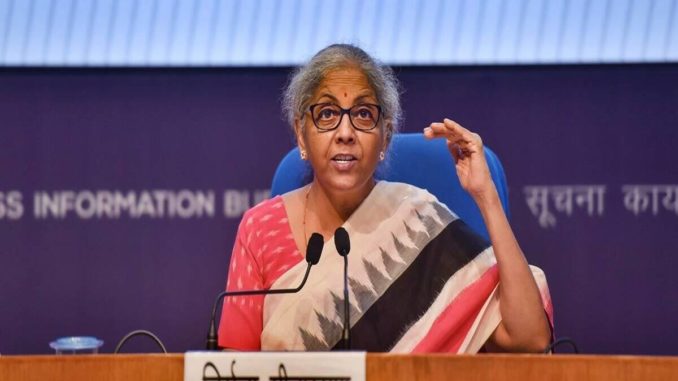
New Delhi: Prime Minister Narendra Modi named Nirmala Sitharaman, previously the country`s defence minister, as India’s finance minister in 2019– thus making her India’s female finance minister after 48 years.
Sitharaman is the first female finance minister after former Prime Minister Indira Gandhi who held the portfolio briefly for a year between July 1969 and June 1970.
Nirmala Sitharaman was born in Tamil Nadu’s Tiruchirapalli on August 18, 1959. On her birthday, here’s looking at 5 major decision taken under her position as the Finance Minister of India. Prime Minister Narendra Modi wished the Union finance minister on her 62nd birthday, to which the FM thanked him for his “blessings and guidance”.
Bank Amalgamation
Nirmala Sitharaman took the major step for amalgamation of Public Sector Banks which was approved by the Union Cabinet in 2020. The cabinet approved the mega consolidation of ten Public Sector Banks into four, including the amalgamation of Oriental Bank of Commerce and United Bank of India into Punjab National Bank, Syndicate Bank into Canara Bank, Andhra Bank and Corporation Bank into Union Bank of India and Allahabad Bank into Indian Bank. The amalgamation that came into effect from April 1, 2020 resulted in the creation of seven large PSBs with scale and national reach with each amalgamated entity having a business of over Rupees Eight lakh crore.
Aatma Nirbhar Bharat
FM Sitharaman announced Aatma Nirbhar Bharat — in line with the vision of Prime Minister Narendra Modi’s Special economic and comprehensive package to fight COVID-19 pandemic in India. In May 2020 Aatma Nirbhar Bharat package worth Rs 20 lakh crore was announced. This was later given further boost by the announcement of Aatma Nirbhar Bharat 3.0 Stimulus worth Rs 2.65 Lakh Crore. In November 2020, FM Sitharaman announced 12 key measures, as part of Government of India’s stimulus to the economy, under Aatma Nirbhar Bharat 3.0. The net total stimulus announced by the Government and Reserve Bank of India till November 2020, to help the nation tide over the COVID-19 pandemic, works out to Rs 29.87 lakh crore, which is 15% of national GDP. Out of this, stimulus worth 9% of GDP has been provided by the government.
Relief in personal income-tax and simplification of taxation in Budget 2020:
In order to provide relief and simplify the taxation regime, it is proposed to provide an option to individual and Hindu undivided family to be taxed at following lower rates if they do not avail specified exemption/deductions:
| Total Income (Rs) | Rate (%) |
| Upto 2,50,000 | Nil |
| From 2,50,001 to 5,00,000 | 5 |
| From 5,00,001 to 7,50,000 | 10 |
| From 7,50,001 to 10,00,000 | 15 |
| From 10,00,001 to 12,50,000 | 20 |
| From 12,50,001 to 15,00,000 | 25 |
| Above 15,00,000 | 30 |
Sitharaman unveils new Covid recovery package, expands credit relief
In June 2021, FM Sitharaman announced Rs 1.5 lakh crore of additional credit for small and medium businesses, more funds for the healthcare sector, loans to tourism agencies and guides, and waiver of visa fee for foreign tourists as part of a package to support the pandemic-hit economy. Together with previously announced Rs 93,869 crore spending on providing free foodgrains to the poor till November and additional Rs 14,775 crore fertiliser subsidy, the stimulus package – mostly made up of government guarantee to banks and microfinance institutions for loans they extend to Covid-hit sectors – totalled up to Rs 6.29 lakh crore.
Reforms in eight key sectors
In 2020, FM Nirmala Sitharaman announced reforms in eight key sectors –Coal Sector, Defence Sector, Mineral Sector, Civil Aviation Sector, Power Sector, Social Infrastructure: Boosting Private Sector Investment Through Revamped Viability Gap Funding Scheme (Rs 8,100 Crore), Space Sector: Boosting Private Participation In Space Activities and Atomic Energy Related Reforms. The key highlights of the reforms were — Commercial Mining introduced in Coal Sector; Diversified Opportunities in Coal Sector; Liberalised Regime in Coal Sector; Enhancing Private Investments and Policy Reforms in Mineral Sector; Enhancing Self Reliance in Defence Production; Policy Reforms in Defence Production; Efficient Airspace Management for Civil Aviation; More World-Class Airports through PPP; India to become a global hub for Aircraft Maintenance, Repair and Overhaul (MRO); Tariff Policy Reform in Power Sector; Privatization of Distribution in UTs; Boosting private sector investment through revamped Viability Gap Funding Scheme in Social Sector; Boosting private participation in space activities; and Reforms in Atomic Energy Sector
Bureau Report
Leave a Reply